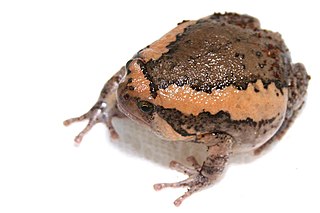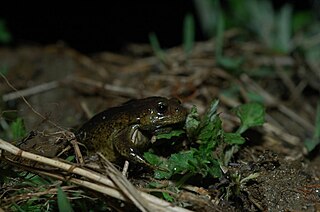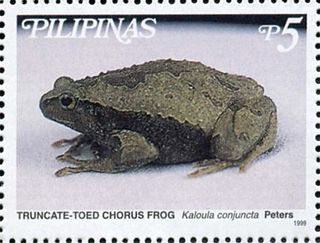
The banded bullfrog is a species of frog in the narrow-mouthed frog family Microhylidae. Native to Southeast Asia, it is also known as the Asian painted frog, digging frog, Malaysian bullfrog, common Asian frog, and painted balloon frog. In the pet trade, it is sometimes called the chubby frog. Adults measure 5.4 to 7.5 cm and have a dark brown back with stripes that vary from copper-brown to salmon pink.

Kaloula is a genus of microhylid frogs found in southern and eastern Asia. They are sometimes known as the Asian narrowmouth toads.

Kaloula baleata, the flower pot toad or sometimes the smooth-fingered narrow-mouthed frog, is a species of narrow-mouthed toad. It is native to India, Borneo, Indochinese Peninsula, Java, Malay Peninsula and Philippines where it lives in lowland rainforests and is tolerant of disturbed sites. The IUCN lists it as being of "Least Concern".

Uperodon taprobanicus, also known as the Sri Lankan bullfrog, Sri Lankan painted frog, Sri Lankan kaloula, Ceylon kaloula, Indian painted frog, or painted globular frog, is a species of narrow-mouthed frog found in Nepal, Bangladesh, southern and eastern India, and Sri Lanka up to an altitude of about 1300 metres. It can grow to an adult length of up to 75 millimetres(7.5 cm) long from snout to vent. It was originally described as a subspecies of Kaloula pulchra, ssp. taprobanica. The IUCN lists it as being of "Least Concern".

The boreal digging frog is a species of microhylid, or "narrow-mouthed," frog found in Northeast Asia. Its range covers much of central and northeastern China, the Korean Peninsula, and Jeju Island. Adult boreal digging frogs are roughly 4.5 cm in length, round in shape with toad-like speckled skin. Tadpoles are up to 35 mm (1.4 in) in length.

Bilbo's rain frog is an amphibian species in the family Brevicipitidae, endemic to South Africa. The frog was named after Bilbo Baggins, the main character from The Hobbit by J.R.R Tolkien. The frog was named as such because the scientist who discovered it used to read the novel to his children. Its natural habitats are temperate grasslands and edges of wood plantations, wherein it spends most of its time in its burrow. The species is threatened by construction, maintenance of roads, silviculture, general habitat degradation/habitat loss, and by road traffic. As a result, it is listed as Near Threatened in the IUCN Red List of Threatened Species.

Glyphoglossus brooksii is a species of frog in the family Microhylidae. It is endemic to Borneo and found in Kalimantan (Indonesia) and Sarawak (Malaysia). Its common names are Brooks' squat frog and Brooks' burrowing frog. It is named after Mr. Cecil J. Brooks who collected the holotype "in a hole whilst prospecting" in Bidi, Sarawak.

Glyphoglossus guttulatus, also known as Burmese squat frog, blotched burrowing frog, orange burrowing frog, or striped spadefoot frog, is a species of frog in the family Microhylidae. It is found in Myanmar, Thailand, Cambodia, Laos, and Vietnam. It is uncertain whether it is present in the Peninsular Malaysia.

Glyphoglossus molossus is a species of frog in the family Microhylidae. Its common names include blunt-headed burrowing frog and balloon frog.
Kalophrynus subterrestris is a species of frog in the family Microhylidae. It endemic to Borneo where it is known from Sabah and Sarawak (Malaysia), although it is also presumed to be present in Kalimantan (Indonesia) and Brunei. Common names burrowing grainy frog and Labang sticky frog have been coined for this species.

The Philippine narrowmouth toad or the truncate-toed chorus frog is a species of frog in the family Microhylidae. It is endemic to the Philippines. Its natural habitats are subtropical or tropical dry forests, subtropical or tropical moist lowland forests, subtropical or tropical moist shrubland, subtropical or tropical seasonally wet or flooded lowland grassland, rivers, intermittent rivers, freshwater lakes, intermittent freshwater lakes, freshwater marshes, intermittent freshwater marshes, arable land, pastureland, plantations, rural gardens, heavily degraded former forest, water storage areas, ponds, irrigated land, and seasonally flooded agricultural land. It is threatened by habitat loss.

The Kalinga narrowmouth toad is a species of frog in the family Microhylidae. It is endemic to the Philippines. Its natural habitats are subtropical or tropical moist lowland forests, subtropical or tropical moist montane forests, arable land, pastureland, and plantations. It is threatened by habitat loss.
The Bicol narrowmouth toad or Catanduanes narrow-mouthed frog is a species of frog in the family Microhylidae. It is endemic to the Philippines, where it is found in the Bicol Peninsula and Catanduanes Island. Its natural habitats are subtropical or tropical moist lowland forests, subtropical or tropical moist montane forests, pastureland, plantations, rural gardens, and heavily degraded former forest. It is threatened by habitat loss.

Kaloula mediolineata is a species of frog in the family Microhylidae. It is found in mainland Thailand, Laos, southwestern Vietnam, and possibly Cambodia.

The Luzon narrow-mouthed frog is a species of frogs in the family Microhylidae.

Kaloula rugifera, the Sichuan digging frog or Szechwan narrowmouth toad, is a species of frog in the family Microhylidae found in China.
Kaloula verrucosa, the verrucous digging frog or Chinese narrowmouth toad, is a species of frog in the family Microhylidae. It is only known from the Yunnan–Guizhou Plateau of southwestern China in Sichuan, Yunnan, and Guizhou provinces, but it is expected to occur in adjacent Myanmar, Laos, and Vietnam. It is a very common species that lives in cultivated fields and in villages. Breeding takes place in temporary pools, ponds, and ditches.
Kaloula walteri is a species of frog in the family Microhylidae. It is endemic to the Philippines, where it is found in the mountains of southeastern Luzon Island and Polillo Island. The specific name walteri honors Walter C. Brown, an American herpetologist. Common name Walter's narrow-mouthed frog has been proposed for it. Kaloula walteri is most closely related to Kaloula rigida.
Kaloula nonggangensis is a species of frog in the family Microhylidae. It is endemic to China, where it is so far only known from the vicinity of its type locality in Nonggang National Nature Reserve in Longzhou County, southwestern Guangxi. Its range might extend into nearby Vietnam. Common name Nonggang narrow-mouthed frog has been coined for it.

Kaloula latidisca, also known as wide-disked narrow-mouthed frog, wide-disked painted frog, wide-disked bullfrog, Malaya painted bullfrog, Malayan painted bullfrog, and Malay painted sticky frog, is a species of frogs in the family Microhylidae. It is endemic to the Malay Peninsula and occurs in southern Myanmar, Peninsular Thailand, and (northern) Peninsular Malaysia. The specific name latidisca refers to the comparatively wide finger discs of this frog. Kaloula latidisca is most similar to Kaloula baleata and Kaloula indochinensis.















